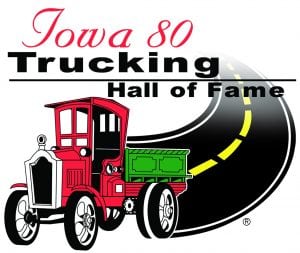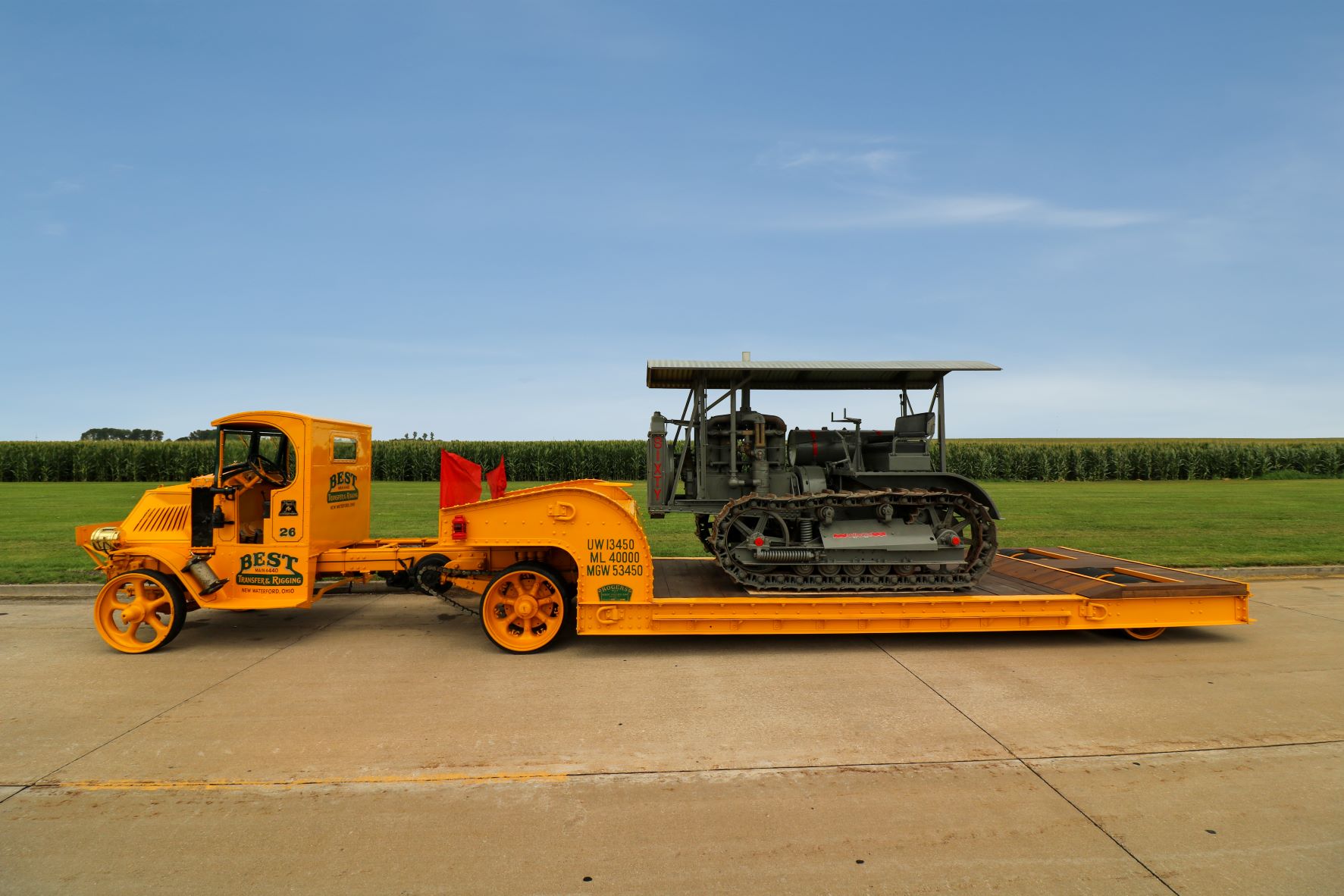
Trucks on Display
Below is a sampling of the many trucks on display in our Trucking Hall of Fame® Exhibit Hall. Check out our app for more information, photos, and an audio recording for each truck. Click here to download.

1926 Mack AC with 1926 Rogers Trailer & Caterpillar Sixty Tractor
Engine Type:
4-Cylinder 471 Cubic Inch, 50 Horsepower
Transmission Type:
5-Speed: 4 Forward Speeds & 1 Reverse
Truck Information:
This is a 1926 Mack AC. It looks the same as it did when Mack started making them in 1916. It has a C-cab with a forward-opening windshield, but there wasn't much need for airflow through the windshield since there were no doors. The tires are solid rubber, and they are well worn down; they could not go flat, but they could wear out. This has the Renault-style radiator behind the engine. There is a hand crank on the front that you would have to turn to get the truck started. The headlights on the truck and trailer are kerosene-powered. It is a chain drive. Mack continued to use the same design for the AC until 1937. There wasn't much that could go wrong with a truck like this, and there wasn't much that most owners couldn't fix. If the chain broke, you just replaced a link; most people could do that. A truck like this with a heavy trailer probably did not travel very far. Top Speed: 15-20 MPH. The 20-ton trailer connected to this truck was made by Rogers Brothers Corporation in 1926. The Pennsylvania-based company got its start in 1905; it is the oldest family-owned business in the heavy-duty low-bed trailer industry. Rogers has also made tractors, snowplows, road planes, and vans over the years. Still in business today, the company has established a reputation of quality and excellence. Rogers was even contracted by the United States government to create trailers and troop carriers in World War I, World War II, the Korean War, and the Vietnam War. This trailer would have cost $2,800 brand new. With a 10-foot width, it would be oversized today, but wide trailers were common in the early 20th century because there were no restrictions on trailer width at the time. There is a wheel at the front of the trailer that controls its brakes. The truck brakes were not strong enough to hold the trailer back. So, if you were going down the road, some brave soul had to stand on the trailer and apply the trailer brakes when the driver asked for them. The arch connecting the trailer to the truck was a feature developed by Rogers in 1923. Because of its resemblance to a goose’s neck, it became known as a “gooseneck” – a term that is still used today. On the trailer is a Caterpillar Model Sixty crawler tractor. It’s famous for its overhanging radiator, individually mounted cylinders, lever controls, and open clutch. The model was first introduced in 1919 by the C. L. Best Tractor Company as the Best 60 Tracklayer and was produced in Peoria, IL (the ‘PA’ series) and San Leandro, CA (‘A’ series); it was the company’s most successful tractor. When C.L. Best Tractor merged with the Holt Manufacturing to form the Caterpillar Tractor Company in April 1925, the name of this model changed from Best 60 to Caterpillar Sixty. The company stopped production of the tractor in 1931; by that point, they had made nearly 19,000 of this model. It weighs approximately 21,000 pounds and has a 4-cylinder, 60 horsepower engine. The Caterpillar Sixty was a marvel of engineering, a legend in its own time. It is known as an innovation where power, suspension, and design come together in a machine that performs far in excess of those envisioned by the designers. There is no blade on the Caterpillar Sixty; though you could buy a blade attachment to push dirt, they weren’t as commonly used for that purpose as they are today. Judging from the wear on the hitch, this one was used extensively.
4-Cylinder 471 Cubic Inch, 50 Horsepower
Transmission Type:
5-Speed: 4 Forward Speeds & 1 Reverse
Truck Information:
This is a 1926 Mack AC. It looks the same as it did when Mack started making them in 1916. It has a C-cab with a forward-opening windshield, but there wasn't much need for airflow through the windshield since there were no doors. The tires are solid rubber, and they are well worn down; they could not go flat, but they could wear out. This has the Renault-style radiator behind the engine. There is a hand crank on the front that you would have to turn to get the truck started. The headlights on the truck and trailer are kerosene-powered. It is a chain drive. Mack continued to use the same design for the AC until 1937. There wasn't much that could go wrong with a truck like this, and there wasn't much that most owners couldn't fix. If the chain broke, you just replaced a link; most people could do that. A truck like this with a heavy trailer probably did not travel very far. Top Speed: 15-20 MPH. The 20-ton trailer connected to this truck was made by Rogers Brothers Corporation in 1926. The Pennsylvania-based company got its start in 1905; it is the oldest family-owned business in the heavy-duty low-bed trailer industry. Rogers has also made tractors, snowplows, road planes, and vans over the years. Still in business today, the company has established a reputation of quality and excellence. Rogers was even contracted by the United States government to create trailers and troop carriers in World War I, World War II, the Korean War, and the Vietnam War. This trailer would have cost $2,800 brand new. With a 10-foot width, it would be oversized today, but wide trailers were common in the early 20th century because there were no restrictions on trailer width at the time. There is a wheel at the front of the trailer that controls its brakes. The truck brakes were not strong enough to hold the trailer back. So, if you were going down the road, some brave soul had to stand on the trailer and apply the trailer brakes when the driver asked for them. The arch connecting the trailer to the truck was a feature developed by Rogers in 1923. Because of its resemblance to a goose’s neck, it became known as a “gooseneck” – a term that is still used today. On the trailer is a Caterpillar Model Sixty crawler tractor. It’s famous for its overhanging radiator, individually mounted cylinders, lever controls, and open clutch. The model was first introduced in 1919 by the C. L. Best Tractor Company as the Best 60 Tracklayer and was produced in Peoria, IL (the ‘PA’ series) and San Leandro, CA (‘A’ series); it was the company’s most successful tractor. When C.L. Best Tractor merged with the Holt Manufacturing to form the Caterpillar Tractor Company in April 1925, the name of this model changed from Best 60 to Caterpillar Sixty. The company stopped production of the tractor in 1931; by that point, they had made nearly 19,000 of this model. It weighs approximately 21,000 pounds and has a 4-cylinder, 60 horsepower engine. The Caterpillar Sixty was a marvel of engineering, a legend in its own time. It is known as an innovation where power, suspension, and design come together in a machine that performs far in excess of those envisioned by the designers. There is no blade on the Caterpillar Sixty; though you could buy a blade attachment to push dirt, they weren’t as commonly used for that purpose as they are today. Judging from the wear on the hitch, this one was used extensively.
< Return To Truck List

